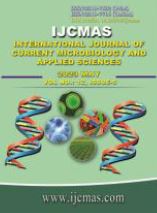


 National Academy of Agricultural Sciences (NAAS)
National Academy of Agricultural Sciences (NAAS)

|
PRINT ISSN : 2319-7692
Online ISSN : 2319-7706 Issues : 12 per year Publisher : Excellent Publishers Email : editorijcmas@gmail.com / submit@ijcmas.com Editor-in-chief: Dr.M.Prakash Index Copernicus ICV 2018: 95.39 NAAS RATING 2020: 5.38 |
Udder and teat typology: The trough (bowl) was the most common, followed by round, goaty, and pendulous udder types. In a similar vein, cylindrical teats were the most common, followed by funnel, bottles, and pears. The majority of cows with (bowl-shaped) udders wear 1 to 4 parity. (Pendulous-shaped) udders show a rising trend, with parity advancement being lowest in 1 parity cows and highest in 5 and above parity cows. The skin covering the teat is smooth when the udder is distended with milk, but it wrinkles after the milk is removed. Buffaloes have thicker teat walls, larger teat cisterns, longer teat canals, and different gland cisterns than other animals. Morphological measurements in cows increased as lactation progressed and lactation parity increased. According to several studies, the characteristics of the udder and milk yield are positively correlate. The relationship between udder characteristics and milk yield can be a useful tool in dairy production system animal selection. However, teat size and shape have no bearing on udder size, shape, or milk production. Understanding the anatomy of the mammary glands and how milk accumulates and is store can help dairy ruminants produce more milk, improve milking ability, adapt to longer milking intervals, and milk more quickly using streamlined procedures. Lactation stage, parity, breed, species, and time between milkings all had an effect on how the milk was distribute in the udder. Milk is stored in the alveolar and cisternal chambers of the udder. We recommend using the udder cistern area as a guiding parameter for the possibility of storing udder milk when determining the ideal milking frequencies for each ruminant based on the production system.
 |
 |
 |
 |
 |